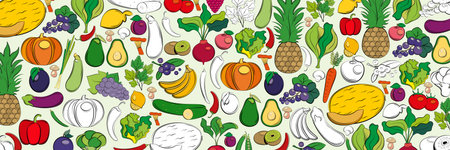1. Preparing Your Soil Naturally
If you want a healthy summer harvest from your organic garden, it all starts with building rich, living soil. Healthy soil is the foundation for strong plants, fewer pests, and flavorful vegetables. Here are some best practices to help you prepare your soil naturally:
Composting: Nature’s Gold
Adding compost is one of the easiest ways to boost your soil’s fertility. Compost is made from kitchen scraps, yard waste, and other natural materials that have broken down over time. Simply spread a few inches of finished compost on top of your garden beds in spring or mix it into the top layer of soil. Compost improves drainage, adds nutrients, and encourages beneficial microbes.
Natural Amendments to Enrich Your Soil
Besides compost, there are several organic amendments you can add depending on what your soil needs. Here’s a quick guide:
| Amendment | Main Benefit | How to Use |
|---|---|---|
| Worm Castings | Boosts plant growth, adds microbes | Mix into planting holes or topdress beds |
| Bone Meal | Adds phosphorus for strong roots & blooms | Sprinkle around root zones before planting |
| Blood Meal | Packs nitrogen for leafy growth | Work into soil before planting greens or corn |
| Kelp Meal | Provides trace minerals & promotes resilience | Add small amounts to beds each season |
| Aged Manure (from herbivores) | Improves fertility and structure | Apply a thin layer and dig in well ahead of planting |
The Power of Crop Rotation
Certain crops take more nutrients from the soil than others. By rotating what you plant in each bed every year, you can help balance out soil nutrients and prevent diseases from building up. For example, don’t plant tomatoes in the same spot two years in a row—instead, follow them with beans or peas which add nitrogen back to the soil.
Simple Crop Rotation Plan Example:
| Year 1 | Year 2 | Year 3 |
|---|---|---|
| Tomatoes & Peppers (heavy feeders) | Beans & Peas (nitrogen fixers) | Lettuce & Carrots (light feeders) |
Troubleshooting: Testing Your Soil
If you’re not sure what your soil needs, try a simple home test kit or contact your local county extension office for advice. Knowing if your pH or nutrient levels are off can help you choose the right amendments for a thriving summer garden.
2. Choosing the Right Summer Crops
Picking the right crops is key to a successful organic summer garden, especially with America’s diverse climates. When temperatures rise, it’s important to choose heat-tolerant vegetables and herbs that will thrive in your area. Below are some popular choices and tips for selecting non-GMO, organic seeds.
Popular Heat-Tolerant Vegetables and Herbs
| Crop | Climate Suitability | Notes |
|---|---|---|
| Tomatoes | Most U.S. regions (full sun) | Choose disease-resistant, heirloom varieties for better flavor and resilience. |
| Peppers (bell & hot) | Southwest, Southeast, Midwest | Peppers love heat—great for salsas and grilling! |
| Okra | Southeast, South Central, Southern California | Tolerates drought; pick pods young for best texture. |
| Zucchini & Summer Squash | Nationwide (warm soils) | Prolific producers; harvest regularly to encourage more fruit. |
| Basil | Nationwide (warm, sunny spots) | Pairs perfectly with tomatoes; pinch flowers to promote leaf growth. |
| Cilantro (slow-bolt varieties) | Western states, cooler nights preferred | Look for slow-bolting types to extend harvest into summer. |
| Eggplant | Southeast, Southwest, California | Loves heat; needs consistent watering for best results. |
| Sweet Potatoes | Southeast, South Central, warm regions | Drought-tolerant once established; needs long growing season. |
Sourcing Non-GMO, Organic Seeds
If you want a truly organic garden, start with non-GMO and certified organic seeds. Here’s how:
Tips for Selecting the Best Seeds:
- Check Labels: Look for “USDA Organic” and “Non-GMO Project Verified” seals on packets.
- Shop Local: Visit local nurseries or farmers’ markets—they often carry regionally adapted seed varieties.
- Order from Trusted Suppliers: Reputable online retailers like Seed Savers Exchange, Baker Creek Heirloom Seeds, or Johnny’s Selected Seeds offer wide selections of organic seeds suited for American gardens.
- Ask for Advice: Don’t hesitate to ask experienced gardeners or extension services about which varieties perform best in your specific area.
Caring for Your Seeds:
- Store seeds in a cool, dry place until planting time to maintain viability.
- If direct-sowing outdoors, wait until soil has warmed up to recommended temperatures for each crop (check seed packet instructions).
Selecting the right crops and quality seeds sets the foundation for a healthy, productive summer harvest—organically!

3. Eco-Friendly Ways to Manage Pests and Weeds
Keeping your summer garden healthy without harsh chemicals is easier than you might think. There are plenty of natural methods you can use to control pests and weeds while keeping your harvest organic and safe for your family. Here are some tried-and-true eco-friendly solutions:
Companion Planting
Certain plants naturally help each other out when grown together. Some repel harmful insects, while others attract beneficial bugs that protect your crops. Check out this easy guide:
| Vegetable | Good Companions | Pest Protection |
|---|---|---|
| Tomatoes | Basil, Marigold | Repels aphids & hornworms |
| Cucumbers | Nasturtiums, Radishes | Repels beetles & aphids |
| Carrots | Onions, Rosemary | Keeps away carrot flies |
| Lettuce | Chives, Garlic | Deters slugs & aphids |
Mulching for Weed Control and Soil Health
Applying a layer of mulch helps lock in moisture, prevents weed growth, and keeps the soil cool during hot summer days. Use organic materials like straw, shredded leaves, or grass clippings. Spread mulch about 2-3 inches thick around your plants, but keep it a few inches away from the stems to prevent rot.
Attracting Beneficial Insects
Encourage good bugs like ladybugs, lacewings, and praying mantises by planting flowers such as dill, fennel, yarrow, and sunflowers. These insects help control aphids, mites, and other common pests naturally.
Common Beneficial Insects & Their Targets:
| Insect | Eats/Controls | How to Attract Them |
|---|---|---|
| Ladybugs | Aphids, mites | Dill, calendula flowers |
| Lacewings | Aphids, thrips, caterpillars | Coriander, cosmos flowers |
| Praying Mantis | Caterpillars, beetles, grasshoppers | Tall grasses & shrubs for shelter |
| Hoverflies | Aphids, mealybugs | Alyssum, marigolds, yarrow flowers |
Organic-Approved Pest Control Solutions
If pests get out of hand, try natural sprays like neem oil or insecticidal soap—both are OMRI-listed (approved for organic gardening). Always follow label instructions and spray early in the morning or late afternoon to avoid harming pollinators. For tougher weeds, hand-pulling is safest; you can also use vinegar-based sprays on walkways or gravel areas (but avoid hitting your veggies).
4. Watering Wisely in the Summer Heat
Hot American summers can make it tough to keep your organic garden hydrated without wasting water. Smart watering techniques not only conserve this precious resource but also help your crops thrive through the heat. Here’s how you can make every drop count:
Mulching: Nature’s Moisture Saver
Mulch acts like a protective blanket for your soil, locking in moisture and keeping roots cool. Organic options like straw, shredded leaves, or grass clippings are easy to find and great for gardens across the U.S. Lay down a 2-3 inch layer around your plants, but be sure to keep mulch away from direct contact with stems to prevent rot.
Benefits of Mulching
| Type of Mulch | Best For | Main Benefit |
|---|---|---|
| Straw | Vegetables & Berries | Excellent moisture retention, weed control |
| Wood Chips | Trees & Shrubs | Long-lasting moisture barrier |
| Grass Clippings | Flower Beds | Readily available, adds nutrients as it breaks down |
Drip Irrigation: Efficient and Effective
If you want to save water and deliver it right where plants need it, consider drip irrigation. This system slowly releases water at the base of each plant, minimizing evaporation and runoff—perfect for those dry Midwest summers or hot California afternoons. Drip kits are easy to set up and can be attached to a timer for hands-off watering.
Why Drip Irrigation Works Well in the U.S.
- Saves up to 50% more water compared to sprinklers
- Keeps foliage dry, reducing risk of fungal diseases common in humid climates like the Southeast
- Easily adjustable for different crop needs and bed layouts
The Right Timing Makes a Difference
When you water is just as important as how you water. In most parts of America, early morning is best because temperatures are cooler and winds tend to be calmer, so less water evaporates. Avoid watering in the heat of the day or late evening—midday sun wastes water, while evening moisture can encourage disease.
Best Watering Times by U.S. Region
| Region | Ideal Watering Time |
|---|---|
| West Coast (CA, OR, WA) | 5 AM – 8 AM |
| Midwest (IL, OH, MI) | 6 AM – 9 AM |
| Southeast (FL, GA, SC) | 6 AM – 8 AM |
| Southwest (AZ, NM, TX) | 5 AM – 7 AM |
| Northeast (NY, PA, MA) | 6 AM – 9 AM |
By using mulch, drip irrigation systems, and proper timing suited for your local climate, you’ll give your organic garden everything it needs to beat the summer heat while saving water.
5. Harvesting and Storing Your Bounty
Tips for Picking Produce at Peak Ripeness
Picking your vegetables and fruits at just the right time ensures the best flavor, nutrition, and texture. Here’s how to tell when some common summer crops are ready:
| Crop | Signs of Ripeness |
|---|---|
| Tomatoes | Rich color (red, yellow, or orange depending on variety), slightly soft to the touch, easily detaches from the vine |
| Cucumbers | Firm, bright green, uniform size, harvested before seeds harden inside |
| Zucchini/Summer Squash | Glossy skin, about 6-8 inches long, tender to touch |
| Peppers | Full color (green, red, yellow), firm skin, no wrinkles or soft spots |
| Green Beans | Smooth skin, snap easily in half, beans inside barely visible |
| Basil & Herbs | Harvest before flowering for best flavor; pick leaves early in the day after dew dries |
Safe Organic Storage Methods
Keeping your harvest fresh without chemicals is simple with a few organic storage tricks. Here are safe ways to store your produce:
- Refrigerate: Leafy greens, herbs (wrap in a damp paper towel and place in a reusable bag)
- Room Temperature: Tomatoes, onions, garlic (keep out of direct sunlight)
- Crisper Drawer: Peppers, carrots, cucumbers (store unwashed until use)
- Avoid Moisture: Store produce dry to prevent mold and spoilage; only wash right before eating or cooking.
- Mason Jars or Glass Containers: Use for cut veggies or leftover herbs to keep them crisp longer.
- Root Cellar or Cool Dark Place: Potatoes and root vegetables do best here if you have space.
Easy Ideas for Sharing or Preserving Your Summer Harvest
If you’ve got more bounty than you can eat, try these simple ideas to make the most of your harvest:
Canning & Pickling
Canning tomatoes or making homemade pickles is a classic American tradition. Use vinegar, salt, and spices to create shelf-stable jars that last all year.
Freezing for Later
Chop up peppers or blanch green beans and freeze them in airtight bags. This keeps their flavor fresh and makes meal prep easier during colder months.
Drying Herbs & Veggies
Tie bundles of herbs and hang them upside down in a cool spot until completely dry. Store in labeled jars. You can also use a dehydrator for fruits like berries or zucchini chips.
Sharing with Neighbors & Local Food Banks
Bless your community by sharing extra produce with friends, family, neighbors, or a local food pantry. It’s a great way to connect with others and reduce food waste!
Quick Reference Table: Storing Common Summer Crops Organically
| Produce | Best Storage Method | Shelf Life (Approx.) |
|---|---|---|
| Basil/Herbs | Damp towel in fridge or jar with water on counter (change water daily) | Up to 1 week |
| Zucchini/Squash | Crisper drawer in fridge, unwashed in perforated bag | 1 week+ |
| Tomatoes | Countertop out of direct sun; refrigerate only if very ripe/cut | Up to 1 week (longer if picked slightly underripe) |
| Cucumbers/Peppers/Beans | Crisper drawer in fridge, unwashed until use | Up to 1 week |
| Berries | Singly layered on paper towel in fridge; don’t wash until eating | 2-3 days |


